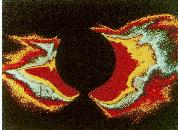The Sun makes itself known throughout much of
the Solar System by the influence the
solar wind of high-speed charged particles constantly blowing off the Sun.
The solar wind may be viewed as an extension of the outer atmosphere of the Sun
(the corona) into interplanetary space.
Components of the Solar Wind
The solar wind contains roughly equal number of electrons and
protons, along with a few
heavier ions, and blows continously
from the
surface of the Sun at an average velocity of about 400 km/second. This is a
remarkable velocity: particles in the solar wind from the Sun's surface travel
at a speed that would allow them to go from Rochester to New York in
seconds!
This wind leads to a mass loss of about 10 million tons of material per year,
which may seem like a large number, but is insignificant relative to the total mass
of the Sun.
The Role of the Coronal Magnetic Field
 |
Magnetic field lines
in the solar corona
|
The solar wind escapes primarily through
coronal holes, which are found predominantly near the
Sun's poles; in
the equatorial plane the
magnetic field lines of the Sun are more likely to close on themselves,
particularly in periods of low solar activity. These closed field lines trap the
hot coronal gases, leading to enhanced X-ray emissions from these hotter regions,
but suppressing contributions to the solar wind.
The adjacent image shows an enhanced image of the solar corona. In this image
the magnetic field lines of the corona correspond approximately to the boundaries
between regions of different color.
Notice that in the equatorial regions the field
lines traced by these color boundaries tend to form closed loops, indicating the
trapping of coronal gas.
Influence of the Solar Wind on the Earth
The solar wind can have a large influence on our planet, particularly in times of
the active Sun (near sunspot maximum) when the wind is strong and can
contain bursts corresponding to flares and coronal mass ejections from the Sun.
The solar wind has a significant influence on our
the Earth's
magnetic field, the IONOSPHERE, and on Earth's
AURORAS,
and on telecommunication systems. For example, there is reason to believe
that a burst of
particles from a coronal mass ejection detected 5 days earlier by SOHO
may have killed the Telstar 401
communications satellite on January 11, 1997.
Earth's Ionosphere and the Sun
The level of activity on the Sun can have a large influence on the Earth's
ionosphere, as illustrated in the following animations.
Much stronger atmospheric ionization (and thus higher electron density)
occurs during an active sun
(e.g. 1990, with 150 sunspots) than in a quiet sun (e.g. 1996, with 10 sunspots).
The level of solar activity has similar effects on related phenomena such as
Earth's auroras.
The "Space Weather" Report
One can monitor
solar data for the last 30 days.
This data gives information on
solar flares, sunspots, X-ray and radio-frequency fluxes.
One can even tune into
Today's Space
Weather, which gives a "weather report" of current and predicted
conditions in space with respect to the solar wind, solar activity, X-ray
activity, and related phenomena.
For example, here is the space weather outlook that was reported
on Feb 26, 2001:
|
Space Weather Outlook
IA. Analysis of Solar Active Regions and Activity from 25/2100Z
to 26/2100Z: Solar activity was low. An optically uncorrelated C1
x-ray flare occurred at 26/0741 UTC. The probable source for this
event was observed by SOHO/LASCO from behind the west limb.
IB. Solar Activity Forecast: Solar activity is expected to be very
low to low.
IIA. Geophysical Activity Summary 25/2100Z to 26/2100Z:
The geomagnetic field was quiet to unsettled. An isolated period of
active conditions occurred at 26/1800 UTC. A slight proton
enhancement was observed which was probably associated with the
event which occurred behind the limb earlier today.
IIB. Geophysical Activity Forecast: The geomagnetic field is
expected to be quiet to unsettled for the forecast period.
|
In this report, the region numbers refer to active areas on the Sun and
C is a classification of solar flares. (Note: M is also a classification
and CME is a coronal mass ejection in such reports.)
As noted above in conjuction with the ill-fated Telstar 401 satellite, "space
weather" may have non-trivial practical consequences.

